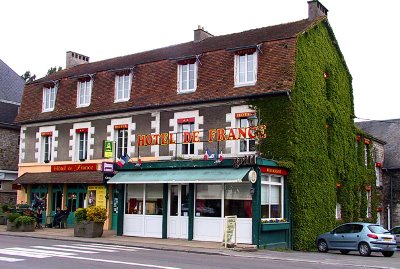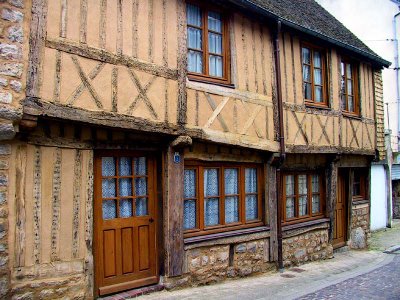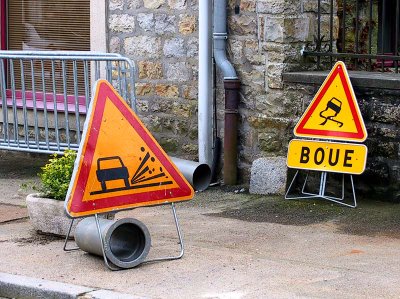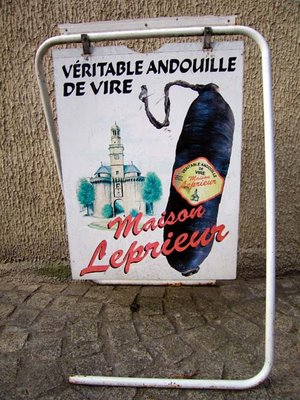We had driven up north Le Mans and stopped at Sées to see the cathedral there and at Carrouges for the château. We had spent an hour or more walking around in Bagnoles-de-l'Orne, the spa town with its hot springs and casino.
At about 6:00 p.m. we arrived in Domfront (pop. 5,000 or so), where we were going to spend the night. We had reserved rooms in a Logis de France hotel on the western edge of town. After checking in, we drove back up into the old town to walk around and take some pictures.
 View from a room over the gardens of the Hôtel de France in Domfront.
View from a room over the gardens of the Hôtel de France in Domfront.The garden is open to guests for a nice stroll.
Domfront is a hilltop town and is the site of the ruins of an old château-fort. Views of the Normandy countryside from up in the old town are spectacular.
 Looking west from the old town at Domfront.
Looking west from the old town at Domfront.Le Mont-Saint-Michel is about an hour's drive west on this road.
Domfront has been a strategic point for at least 10 centuries. According to a sign posted at the site of the old château, the first fort, a wooden structure, was built there in about 1010 A.D.
Later, Henri 1er Beauclerc, a son of William the Conqueror who became overlord of Domfront and later king of England (1100), had a huge stone tower (a donjon in French) built there. It was the largest fortified château in France at the time. When Henri became the English king, Domfront became an English possession.
The Anglo-Norman kings lived in Domfront in the 12th century, and Henry II Plantagenet, Eleanor of Aquitaine, Richard the Lion-Hearted and others spent much time there with "their brillian court of troubadours and poets," according to the Michelin green guide.
A century later, the area came back under the control of the French king in Paris. Then it was taken back by the English from 1336 to 1366 and again from 1418 to 1450, during the Hundred Years War. Domfront was the site of several long sieges during that time, including one that lasted nine months in 1418.
The château was finally dismantled in 1608 because it was no longer needed for defensive purposes. In the 1860s, the ruins were uncovered and turned into a park. Archeological and restoration work continues today.
Obviously, Domfront has a long history of close relations with England and the English. The first time we were there, in May 2005, Walt and I were surprised to see several big groups of English people at the Hôtel de France.
Then while walking around to old town, we found a shop called Les Favorites that stocks and sells products imported from the U.K. -- Heinz Beanz (baked beans), bangers (English breakfast sausages), bottled sauces like A1 and Worcestershire, and, to our great pleasure, big boxes of PG Tips teabags. We bought four or five boxes — about 500 teabags — that day. I used to be able to buy PG Tips tea in California, but up to that day I hadn't found any in France.
On this last trip we couldn't buy any more tea because we were there on a Monday and the English shop is now only open on Thursday and Friday afternoons.
Those restricted hours might be a sign of the current business climate in Domfront. The town doesn't appear to be especially prosperous. There were many empty storefronts. Several of them had nice curtains covering the big windows and potted geraniums sitting on the front steps, so I think they were being used as living space.
There are other sights to see in Domfront. The church has fine tile mosaics, but it is being renovated right now and was closed to visitors the day we were there. There's also a big court house building (le palais de justice) and a fancy town hall. I haven't included pictures of those, or of the ruins of the château.
I like Domfront and am a little sad to see it in its current sleepy state. These things go in cycles, however, and the place will probably perk up in a few years. It's been in existence for a thousand years or so, after all, and has certainly had ups and downs over the centuries.
















"Pretty busy?" You two never stop, you seem to be on your own Tour de France! And it's most enjoyable for us readers. I have heard of Mere Poulard (sorry no accents, I'm writing from the USA now) and I can't believe the prices!
ReplyDelete